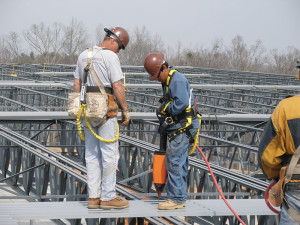Steel floor or roof deck is only as good as its fastening. Whether it is the performance of the product as a diaphragm to transfer wind or seismic forces, resisting wind uplift, acting as a concrete form, providing bracing to beams or joists, or providing a safe working platform during construction, proper fastening makes the deck do its job.
What Choices Do I Have for Fastening Deck?
Traditionally, deck has been installed using welds for fastening to supports and button punches or welds for joining side-laps. However, over the past 30 years, mechanical fasteners such as screws, power actuated fasteners, and proprietary sidelap crimping devices have proven to be viable alternatives.
When welding, it is essential that the finished weld penetrate into the supporting beam or joist, and that the puddle engage the deck on the weld perimeter. The complete welding process usually requires 3 to 6 seconds, or perhaps longer on multiple deck thicknesses or thicker deck. This process requires a welder who is qualified to make these specific welds. Per AWS D1.3 Structural Welding Code – Sheet Steel, arc spot welds can be made through multiple thicknesses of steel deck, as long as the total base metal (bare steel) thickness of the deck does not exceed 0.15 inches.
Screws can be used for both fastening to supporting members and for fastening sidelaps. Typically #10 screws are used for sidelap attachment, and larger #12 or #14 screws are used for support fasteners. The drill points on these screws vary in length depending on the total thickness of the steel to be connected. Screws are installed using torque controlled drills which allow for proper installation without overdriving and stripping the screw. Several manufacturers have developed “stand up” drilling equipment.
Power actuated fasteners (or PAF’s) look similar to short nails that are driven into the supporting structure using either pneumatic pressure or powder cartridges. The driving process allows the fastener to penetrate the steel deck layer and fuses the fastener shank to the base steel supports. The force used for driving the PAF is varied depending upon the steel strength and thickness. Proper driving is ensured by following the manufacturer’s instructions, setting the power regulation on the installation tools, making trial fastenings and visual identification of the fastener head and washer conditions. These fasteners cannot be used for sidelap connections.
Welds, screws and PAF’s can be combined; for instance, welds used for support connections and screws for sidelap connections, or in combination as part of a zoned steel deck diaphragm.
How Should I Choose a Fastening Method?
Generally, arc spot welded support connections are stronger and less flexible than mechanically connected support connections for both shear and uplift if the welding procedure is done properly. This may lead to needing a less dense fastening pattern for the deck, but there are pros-and-cons to be considered for each method.
- Welding is a comparatively slower process and requires a higher level of skill. Inspection requirements are more time consuming also, when compared to many mechanical fasteners.
- Some screws and all power actuated fasteners are proprietary products with strengths and flexibilities unique to that product; therefore they cannot be generically specified.
For deck sidelap connections, welded sidelaps are again stronger and generate less flexible diaphragm performance than screwed or button punched sidelaps, but the weld between the two layers of sheet steel at the side-lap can be difficult. While welded sidelap connections of 22 gage deck are permitted, their use is not recommended. Some proprietary crimped sidelaps have strength and stiffness equal to welds.
How Can I Fasten Deck More Economically?
On larger structures, consider zoning your roof deck connection design and select the fastening pattern to match the uplift and diaphragm demand which will vary across the floor or roof.
Another way to provide for an economic yet well performing deck installation is to provide the deck erector with options. Installer preferences can vary regionally and should be considered. One way to accomplish this is to provide a fastening design that meets diaphragm and uplift requirements using generic welds and/or screws, and allow the deck installer to provide an engineered proprietary alternate connection method which meets strength and stiffness requirements.
In order for the installer to provide an alternate, design requirements including zoned uplift (for roofs) and diaphragm strength demand needs to be provided. The loads need to be indicated as either ASD or LRFD, and noted if they are due to wind or seismic loading. Even if an alternate design is not permitted, this is important information to provide on the drawings.
What Should I Consider When the Deck is Loaded by Wind?
Anytime that deck fasteners are subject to both wind uplift and in-plane shear when loaded as a diaphragm, the combined tension and shear forces on the fasteners must be considered using interaction equations. A key point to remember is that if the shearwalls or other shear collectors are at the edges of the roof, this will combine the highest in-plane shear demand with the highest wind uplift pressures at the edge zones. The 2013 SDI Roof Deck Design Manual provides guidance on how to combine these forces.
How Can I Provide for Quality in the Fastening?
The SDI has developed the ANSI/SDI QA/QC-2011 Standard for Quality Control and Quality Assurance for Installation of Steel Deck which provides requirements for steel deck installation quality (including fastening) in a mandatory format that can be used for inspection purposes. This Standard is incorporated by reference in Chapter 17 of the 2015 International Building Code, and is available for free download from the SDI website. It is highly recommended that designers require compliance with the quality procedures in the standard through incorporation of the Standard in project specifications, even when special inspections are not required.▪

